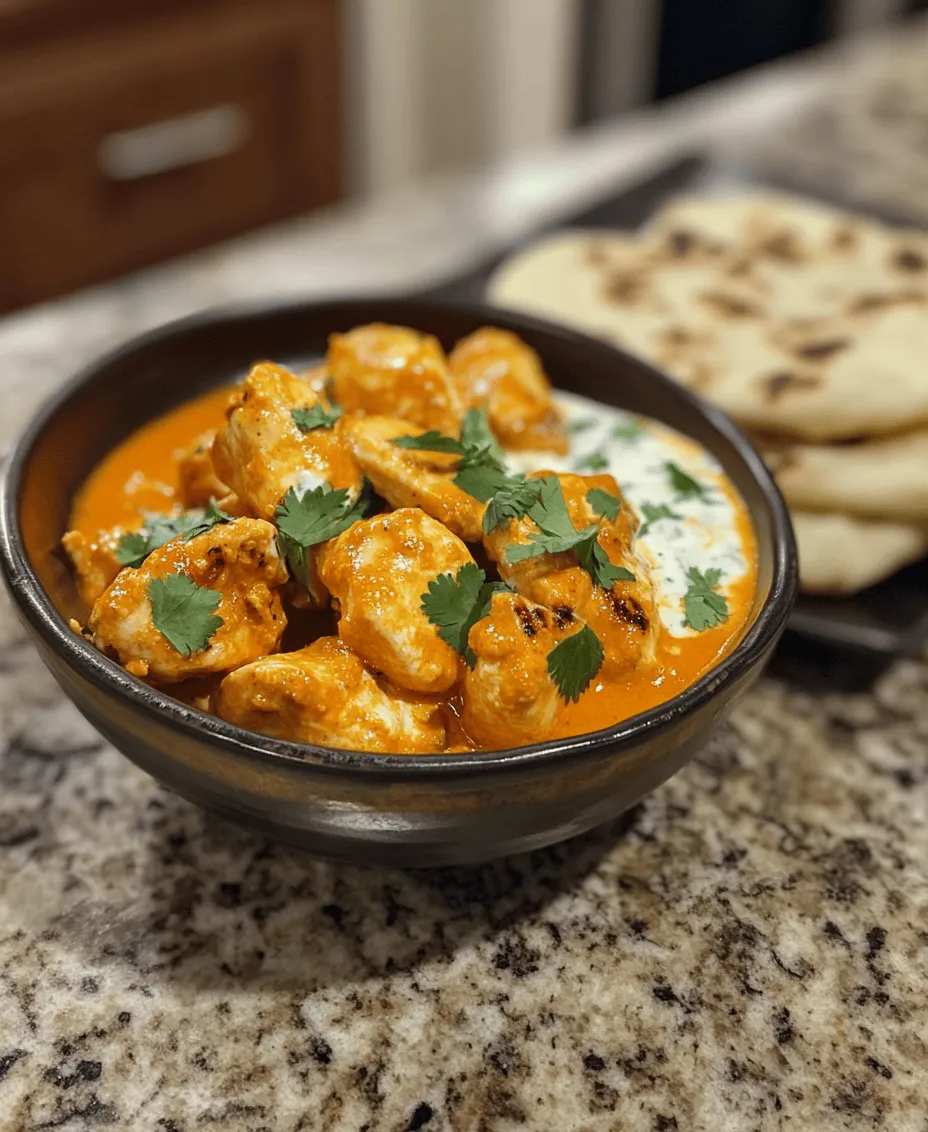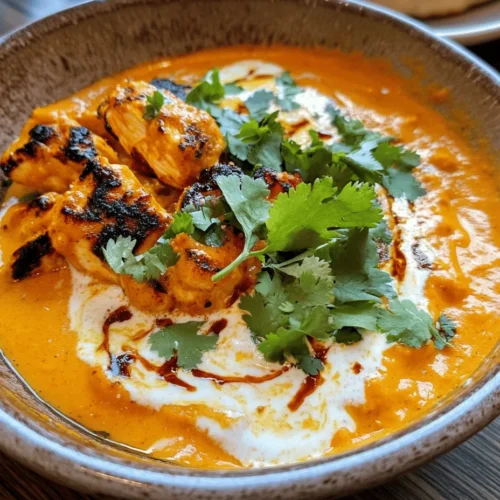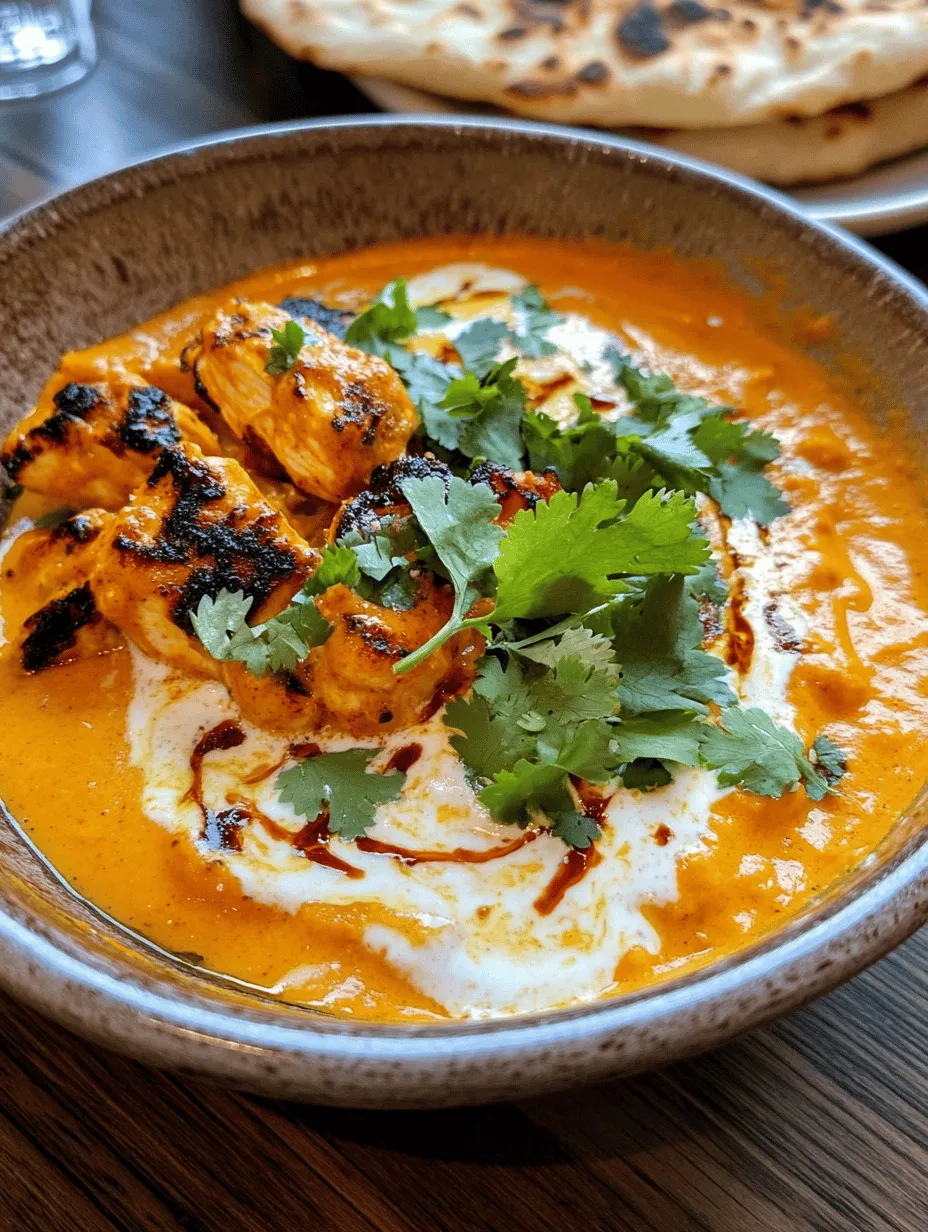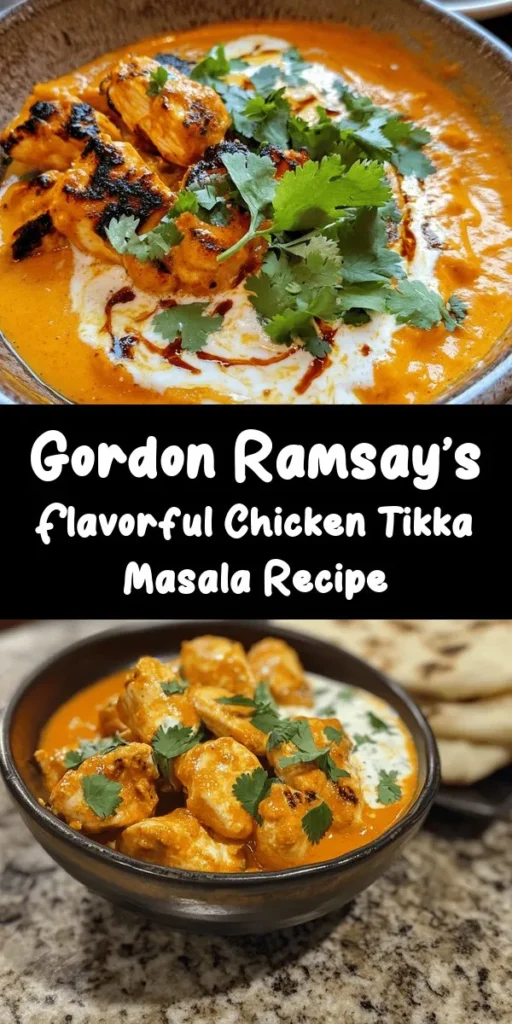Introduction
Explore the rich and aromatic world of Indian cuisine with Gordon Ramsay’s Chicken Tikka Masala Delight. This beloved dish is a harmonious blend of marinated chicken, vibrant spices, and a creamy sauce that tantalizes the taste buds. Renowned for its complexity and depth of flavor, Chicken Tikka Masala has become a favorite not only in its native India but across the globe, often considered the quintessential Indian dish.
In this article, we will guide you through a comprehensive recipe that not only captures the essence of traditional Chicken Tikka Masala but also incorporates chef Ramsay’s signature techniques. Get ready to impress your family and friends with this culinary masterpiece that is both satisfying and comforting.
Understanding Chicken Tikka Masala
Definition and Origins of Chicken Tikka Masala
Chicken Tikka Masala can be simply defined as marinated chicken pieces, traditionally cooked in a tandoor, and then simmered in a rich and creamy tomato-based sauce. The origins of this dish are often debated, with some claiming it hails from India while others argue it was created in the United Kingdom by South Asian immigrants seeking to adapt traditional recipes to local tastes.
The dish is believed to have been popularized in the 1960s and 1970s, especially in British curry houses, where it quickly became a staple on menus. This fusion of flavors and culinary techniques is a testament to the adaptability and appeal of Indian cuisine, making Chicken Tikka Masala a true global phenomenon.
Exploring the Cultural Significance
The cultural significance of Chicken Tikka Masala transcends its mere ingredients. It represents a blend of culinary traditions, showcasing how food can serve as a bridge between cultures. The dish reflects the rich history of Indian spices and cooking methods, while also embodying the innovations brought about by diaspora communities.
In the UK, Chicken Tikka Masala has even been dubbed “the national dish,” symbolizing the integration of Indian flavors into British culinary culture. It’s often served with fragrant basmati rice or naan bread, providing a satisfying meal that connects people across different backgrounds.
Regional Variations of Tikka Masala
While the core elements of Chicken Tikka Masala remain consistent, numerous regional variations exist that highlight local tastes and ingredients. For instance, in India, you may find variations that include more heat and different spice blends, reflecting the diverse culinary practices across the country.
In contrast, the British adaptation tends to be milder and creamier, catering to Western palates. Some variations also incorporate coconut milk or yogurt for a different texture and flavor profile. Each version tells a story, showcasing the adaptability of this dish while maintaining its essential character.
Ingredients Breakdown
To create Gordon Ramsay’s Chicken Tikka Masala Delight, it’s important to understand the ingredients that contribute to its unique flavor profile. The recipe can be broken down into two main components: the chicken marinade and the tikka masala sauce.
Essential Ingredients for the Chicken Marinade
– Chicken: Bone-in, skinless chicken thighs or breasts are typically preferred for their moistness and flavor.
– Yogurt: A key element in the marinade, yogurt not only tenderizes the chicken but also infuses it with flavor.
– Spices: A blend of cumin, coriander, turmeric, garam masala, and chili powder gives the chicken its signature taste.
Importance of Yogurt in Marinating
The role of yogurt in marinating chicken cannot be overstated. Its lactic acid content helps break down protein, resulting in tender and juicy meat. Additionally, the yogurt acts as a medium for the spices to adhere to the chicken, enhancing flavor absorption. This process is crucial for achieving the richly spiced taste that Chicken Tikka Masala is known for.
Role of Spices in Flavor Development
The spices used in the marinade not only contribute heat but also add layers of complexity to the dish. Cumin and coriander provide earthiness, while turmeric adds warmth and a vibrant golden color. Garam masala, a blend of various spices, introduces aromatic notes that are characteristic of Indian cuisine. The combination of these spices creates a well-rounded flavor profile that elevates the chicken.
Key Components of the Tikka Masala Sauce
– Onions: Finely chopped and sautéed to create a flavorful base.
– Garlic and Ginger: Freshly minced to add depth and aroma.
– Tomatoes: Fresh or canned, providing acidity and sweetness to balance the richness of the sauce.
– Heavy Cream: Adds creaminess and richness, creating the signature velvety texture.
The Use of Fresh Aromatics: Onions, Garlic, and Ginger
Aromatic ingredients like onions, garlic, and ginger are fundamental in Indian cooking. When sautéed, they release their natural sugars and essential oils, forming a deeply flavored base for the sauce. This combination of aromatics is what gives Chicken Tikka Masala its characteristic depth and complexity.
Understanding the Importance of Heavy Cream and Tomatoes in the Sauce
The tomatoes in the sauce serve a dual purpose: they provide acidity to balance the rich flavors and contribute a beautiful color. Heavy cream is added at the end to create a luxurious, velvety texture that envelops the chicken, making each bite incredibly satisfying. This combination results in a sauce that is both comforting and indulgent, perfectly complementing the marinated chicken.
Preparation Steps
Now that we’ve explored the ingredients, let’s delve into the preparation steps required to make Gordon Ramsay’s Chicken Tikka Masala Delight.
Marinating the Chicken
The first step in creating this delectable dish is marinating the chicken. This process not only adds flavor but also ensures that the chicken remains moist during cooking.
Importance of Marination Time
For optimal flavor absorption, it’s crucial to allow the chicken to marinate for at least 2 hours, though overnight is ideal. This extended marination time allows the spices and yogurt to penetrate the meat fully, resulting in a more flavorful dish.
Tips for Achieving Maximum Flavor Absorption
1. Cut the Chicken into Uniform Pieces: This ensures even marination and cooking.
2. Use a Ziplock Bag or Bowl: For easy mixing and to minimize cleanup, consider using a resealable bag or a bowl covered with plastic wrap.
3. Massage the Marinade: Gently massage the marinade into the chicken to ensure an even coating.
Cooking the Chicken
Once the chicken has marinated, it’s time to cook it. The method of cooking can significantly affect the final dish.
Grilling vs. Baking: Which Method Works Best?
Both grilling and baking can yield delicious results, but each method offers its own advantages.
– Grilling: This method imparts a smoky flavor that enhances the overall taste of the Chicken Tikka Masala. If you have access to a grill, this is the preferred cooking method. The high heat also helps create a nice char on the chicken, adding to the dish’s complexity.
– Baking: If grilling isn’t an option, baking in a high-temperature oven can also produce excellent results. It’s a more straightforward method and allows for cooking larger batches at once.
Regardless of the cooking method chosen, ensure that the chicken is cooked to a safe internal temperature of 165°F (75°C) for optimal safety and flavor.
As we continue to explore the remaining steps in creating Gordon Ramsay’s Chicken Tikka Masala Delight, prepare to embark on an exciting culinary adventure that will not only satisfy your cravings but also impress those around you with the vibrant flavors of this iconic dish.

Achieving the Perfect Char
To truly embrace the essence of Chicken Tikka Masala, achieving the perfect char on the chicken is essential. This step not only adds a distinct flavor but also enhances the overall presentation of the dish. Start by preheating your grill or oven to a high temperature. If you’re using a grill, ensure the grates are clean and lightly oiled to prevent sticking. For an oven, broil the chicken, placing it on a rack to allow the heat to circulate evenly.
Once the chicken has marinated for at least one hour, thread the pieces onto skewers. This not only makes them easier to handle but also creates a more uniform cooking process. Grill or broil the chicken for about 10-15 minutes, turning occasionally, until you see a beautiful char forming on the outside. The chicken should be cooked through but still juicy on the inside. This charred exterior adds layers of flavor that are crucial to the overall profile of the Chicken Tikka Masala.
Crafting the Tikka Masala Sauce
Sautéing Techniques for Optimal Flavor
While the chicken is grilling, it’s time to focus on crafting the tikka masala sauce. Start by heating a generous amount of oil or ghee in a large, heavy-bottomed pan over medium heat. Once the oil is shimmering, add finely chopped onions and sauté them until they turn golden brown. This caramelization process is vital; it enhances the sweetness of the onions and lays the foundation for your sauce.
Next, add minced garlic and ginger, stirring frequently to prevent burning. The combination of garlic and ginger will infuse the oil with aromatic flavors, setting the stage for the rest of the spices. After a minute, introduce your ground spices—cumin, coriander, turmeric, and garam masala—to the pan. Toasting the spices in the hot oil helps release their essential oils, intensifying their flavors.
Layering Spices: Building Depth in the Sauce
Once the spices are fragrant, it’s time to add the tomatoes. Use either fresh diced tomatoes or canned crushed tomatoes for convenience. Stir the mixture, allowing it to simmer and break down the tomatoes for about 10 minutes. This simmering helps integrate the flavors and gives the sauce a rich texture.
A common practice is to add a bit of sugar or honey at this point to balance the acidity of the tomatoes. After the sauce has thickened, pour in some heavy cream or coconut milk, allowing it to simmer for an additional 5 minutes. This creamy component will give the sauce its characteristic richness and a luxurious mouthfeel.
Combining Chicken and Sauce
The Importance of Simmering for Flavor Fusion
Once your chicken is beautifully charred and your sauce is velvety smooth, it’s time to bring the two together. Remove the skewers from the grill, allowing the chicken to rest for a few minutes before cutting it into bite-sized pieces. This resting time is essential as it helps the juices redistribute, keeping the chicken moist.
Add the chicken pieces to the sauce, gently stirring to coat them thoroughly. Let the mixture simmer for an additional 10 minutes. This simmering not only melds the flavors together but also allows the chicken to absorb the spices and creaminess of the sauce.
Tips for Adjusting Spice Levels
If you prefer a milder dish, consider adding more cream or coconut milk to balance the spices. Conversely, for those who enjoy a bit more heat, feel free to incorporate finely chopped green chilies or a dash of cayenne pepper. Taste the sauce before serving, adjusting the seasoning with salt, pepper, or additional spices as desired.
Serving Suggestions
Ideal Accompaniments for Chicken Tikka Masala
To truly enjoy Gordon Ramsay’s Chicken Tikka Masala Delight, it’s crucial to pair it with the right accompaniments that complement its rich flavors.
Basmati Rice: The Perfect Pairing
Basmati rice is a classic side that pairs beautifully with Chicken Tikka Masala. Its long grains and aromatic quality make it the ideal canvas for soaking up the delicious sauce. To prepare, rinse the basmati rice under cold water until the water runs clear, then soak it for 30 minutes. This step helps achieve perfectly fluffy rice. Cook it in boiling salted water for about 10-12 minutes, or until the grains are tender yet firm. Fluff with a fork before serving, optionally garnishing with a sprinkle of fresh herbs.
Naan Bread: Traditional and Delicious
Naan bread is another fantastic accompaniment. Soft and slightly chewy, it’s perfect for scooping up the chicken and sauce. You can make your own naan at home or purchase ready-made from your local grocery store. If making at home, ensure to cook them in a hot skillet or tandoor for that authentic charred flavor. Serve warm, brushed with garlic butter or sprinkled with chopped cilantro for an added flavor boost.
Creative Serving Ideas
Garnishing Techniques with Fresh Cilantro
Presentation is key when serving Chicken Tikka Masala. To elevate the dish, garnish with freshly chopped cilantro right before serving. This not only adds a pop of color but also contributes a fresh, herbaceous note that balances the richness of the sauce. For an extra touch, consider a drizzle of cream in a decorative swirl over the top.
Presentation Tips to Enhance Visual Appeal
When plating, consider using a large serving dish to showcase the vibrant colors of the chicken and sauce. You could also serve individual portions in bowls for a more rustic feel. Arrange the basmati rice on one side, allowing the tikka masala to spill over the rice slightly. This not only looks appealing but encourages diners to dig in!
Nutritional Information
Analyzing the Nutritional Profile of Chicken Tikka Masala
Understanding the nutritional profile of Chicken Tikka Masala can help you appreciate its balance of flavors and ingredients.
Protein Content from Chicken and Yogurt
Chicken is a lean source of protein, which is essential for muscle repair and growth. In this recipe, the yogurt used in the marinade also contributes to the protein content while providing probiotics that are good for gut health. Each serving of Chicken Tikka Masala can provide a substantial amount of protein, making it a satisfying meal.
Balancing Calories with Healthy Ingredients
While Chicken Tikka Masala is indulgent, balancing the rich ingredients with healthy choices can be achieved. Opting for lean chicken breast and using yogurt instead of heavy cream can reduce the overall calorie count. Additionally, serving it with vegetables like sautéed spinach or a side salad can increase the fiber content, making the meal more nutritious.
Conclusion
Gordon Ramsay’s Chicken Tikka Masala Delight is not just a dish; it’s an experience that brings together rich flavors and culinary artistry. Whether you’re preparing it for a family dinner or a special occasion, this recipe is sure to impress and satisfy. By understanding the ingredients and techniques involved, you can create a dish that is both authentic and uniquely yours. Dive into this culinary adventure and savor the delightful taste of homemade Chicken Tikka Masala. With a perfect char on your chicken, a rich and creamy sauce, and ideal accompaniments, you’ll be well on your way to a memorable meal that celebrates the beauty of Indian cuisine. Enjoy the journey of cooking and the joy of sharing this delightful dish with others!



